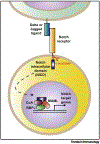Notch Signaling Orchestrates Helminth-Induced Type 2 Inflammation
- PMID: 31103422
- PMCID: PMC6545262
- DOI: 10.1016/j.it.2019.04.003
Notch Signaling Orchestrates Helminth-Induced Type 2 Inflammation
Abstract
Infection with helminth parasites poses a significant challenge to the mammalian immune system. The type 2 immune response to helminth infection is critical in limiting worm-induced tissue damage and expelling parasites. Conversely, aberrant type 2 inflammation can cause debilitating allergic disease. Recent studies have revealed that key type 2 inflammation-associated immune and epithelial cell types respond to Notch signaling, broadly regulating gene expression programs in cell development and function. Here, we discuss new advances demonstrating that Notch is active in the development, recruitment, localization, and cytokine production of immune and epithelial effector cells during type 2 inflammation. Understanding how Notch signaling controls type 2 inflammatory processes could inform the development of Notch pathway modulators to treat helminth infections and allergies.
Keywords: Notch; Type 2; adaptive; allergy; helminth; innate.
Copyright © 2019 Elsevier Ltd. All rights reserved.
Figures



Similar articles
-
What Can Parasites Tell Us About the Pathogenesis and Treatment of Asthma and Allergic Diseases.Front Immunol. 2020 Sep 11;11:2106. doi: 10.3389/fimmu.2020.02106. eCollection 2020. Front Immunol. 2020. PMID: 33013887 Free PMC article. Review.
-
ILC2s-Trailblazers in the Host Response Against Intestinal Helminths.Front Immunol. 2019 Apr 4;10:623. doi: 10.3389/fimmu.2019.00623. eCollection 2019. Front Immunol. 2019. PMID: 31019505 Free PMC article. Review.
-
On the hunt for helminths: innate immune cells in the recognition and response to helminth parasites.Cell Microbiol. 2008 Sep;10(9):1757-64. doi: 10.1111/j.1462-5822.2008.01174.x. Epub 2008 May 26. Cell Microbiol. 2008. PMID: 18505479 Free PMC article. Review.
-
Cytokines and beyond: Regulation of innate immune responses during helminth infection.Cytokine. 2020 Sep;133:154527. doi: 10.1016/j.cyto.2018.08.021. Epub 2018 Sep 18. Cytokine. 2020. PMID: 30241895 Free PMC article. Review.
-
The ChAT-acetylcholine pathway promotes group 2 innate lymphoid cell responses and anti-helminth immunity.Sci Immunol. 2021 Mar 5;6(57):eabe3218. doi: 10.1126/sciimmunol.abe3218. Sci Immunol. 2021. PMID: 33674322 Free PMC article.
Cited by
-
Upregulated expression of Notch1/4 - JAG-1/DLL-1 detected in allergic rhinitis.Allergy Asthma Clin Immunol. 2023 May 14;19(1):41. doi: 10.1186/s13223-023-00793-4. Allergy Asthma Clin Immunol. 2023. PMID: 37183251 Free PMC article.
-
The role and mechanism of HMGB1-mediated Notch1/Hes-1 pathway in anxiety and depression-like behaviors in mice with chronic rhinosinusitis.Mol Med. 2025 Jan 9;31(1):8. doi: 10.1186/s10020-024-01057-6. Mol Med. 2025. PMID: 39789446 Free PMC article.
-
Basophil responses in susceptible AKR mice upon infection with the intestinal helminth parasite Trichuris muris.Parasite Immunol. 2023 Aug;45(8):e12999. doi: 10.1111/pim.12999. Epub 2023 Jul 6. Parasite Immunol. 2023. PMID: 37415265 Free PMC article.
-
Allergen immunotherapy combined with Notch pathway inhibitors improves HDM-induced allergic airway inflammation and inhibits ILC2 activation.Front Immunol. 2024 Feb 2;14:1264071. doi: 10.3389/fimmu.2023.1264071. eCollection 2023. Front Immunol. 2024. PMID: 38371944 Free PMC article.
References
-
- Campbell SJ et al. (2016) A Critical Appraisal of Control Strategies for Soil-Transmitted Helminths. Trends Parasitol. 32, 97–107 - PubMed
Publication types
MeSH terms
Substances
Grants and funding
LinkOut - more resources
Full Text Sources

